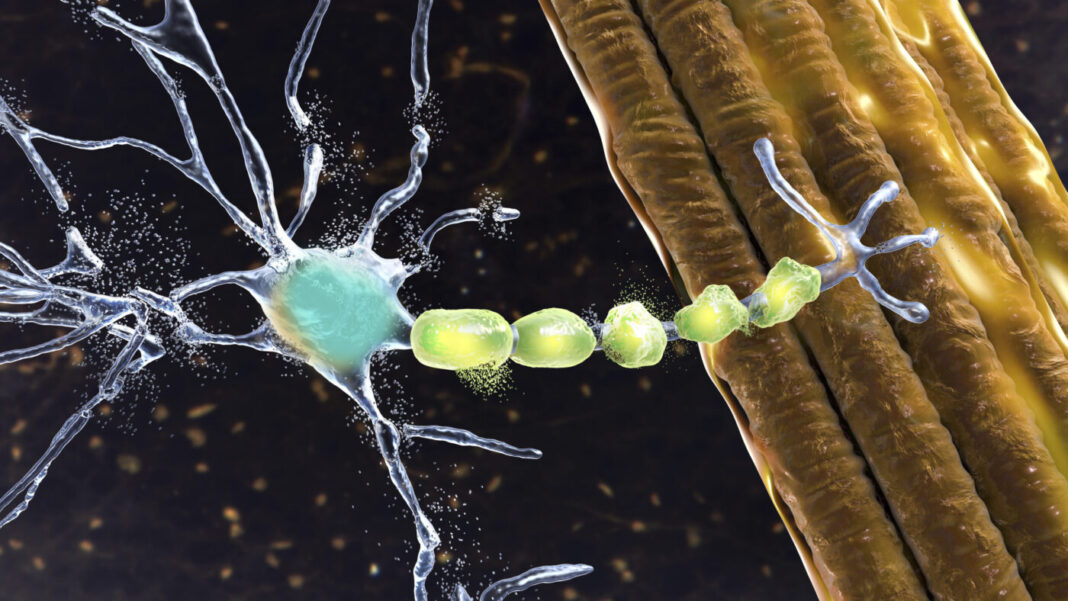Scientists have identified several potential therapeutic targets for amyotrophic lateral sclerosis (ALS) using an artificial intelligence (AI)-powered target discovery engine to analyze dysregulated gene expression in large, publicly available ALS datasets.
The researchers used a proprietary AI platform called PandaOmics from Insilico Medicine, a clinical stage end-to-end AI-driven drug discovery company. PandaOmics uses advanced deep learning models to predict target genes associated with a given disease by combining omics and text-based AI scores, financial scores, and key opinion leader scores. The algorithm can prioritize protein targets for novelty, confidence, commercial tractability, druggability, safety, and other attributes that drive decisions regarding target selection.

The findings were published in an article in the journal Frontiers in Aging Neuroscience titled “Identification of Therapeutic Targets for Amyotrophic Lateral Sclerosis Using PandaOmics–An AI-Enabled Biological Target Discovery Platform,” on July 7, 2022. Merit Cudkowicz, MD, chief of neurology and director of the Healey & AMG Center for ALS at Massachusetts General Hospital (MGH) and Harvard Medical School (HMS), and Alex Zhavoronkov, PhD, founder and CEO of Insilico Medicine, are the corresponding authors, and Frank Pun, PhD, head of Insilico’s Greater Bay Area team is the lead author of the study.
“Our study provides new insights into ALS pathophysiology and demonstrates how AI speeds up the target discovery process and opens up new opportunities for therapeutic interventions,” the authors noted.
ALS, also known as Lou Gehrig’s disease, is a severe progressive neurodegenerative disease that affects more than 700,000 people worldwide. Patients lose muscle movement that rapidly affects their ability to walk, talk, eat and finally breathe. Life expectancy ranges between two to five years from the onset of symptoms. Currently, available drugs for ALS do not reverse or stop this progressive loss of function, calling for the urgent development of new targeted therapeutics.
In the current study, the international team analyzed gene expression profiles in central nervous system samples from 237 patients and 91 controls from public datasets, and motor neurons derived directly from induced pluripotent stem cells from 135 patients and 31 controls, from Answer ALS, the largest and most comprehensive ALS research project to date.
The investigators identified 17 high-confidence and 11 new therapeutic targets. They validated 18 of these targets in an established fruit fly model of ALS (c9ALS Drosophila) to demonstrate functional correlations to ALS. The investigators also conducted rescue experiments and showed that suppression of eight new targets (KCNB2, KCNS3, ADRA2B, NR3C1, P2RY14, PPP3CB, PTPRC, and RARA) rescued neurodegeneration of the eye and restored a normal phenotype. The team has disclosed all potential therapeutic targets at ALS.AI.
“The results of this collaborative research effort show what is possible when we bring together human expertise with AI tools to discover new targets for diseases where there is a high unmet need,” said Zhavoronkov. “This is only the beginning.”

“It is exciting to see the power of AI to help understand ALS biology,” said Cudkowicz. “Through Sean Healey and his friends, I was introduced to Dr. Zhavoronkov and the Insilico team. We immediately saw the potential to connect the Insilico team with the multidisciplinary Answer ALS team. We look forward to the next steps to turn this knowledge into new targets for treatments for people living with ALS.”
“From AI-powered target discovery based on massive datasets, to biological validation by multiple model systems (fly, mouse, human iPS cells), to rapid clinical testing through investigator-initiated trials, the study represents a new trend that may dramatically reduce the costs and duration and more importantly the success rate of developing medicines, especially for neurodegenerative diseases” said Bai Lu, PhD, professor at Tsinghua University and founder of 4B Technologies.
“This demonstrates the power of our biology AI platform, PandaOmics, in target discovery. It is impressive that around 70% (18 out of 28) targets identified by AI were validated in a preclinical animal model,” said Feng Ren, PhD, Co-CEO and CSO of Insilico Medicine. “We are working with collaborators to progress some targets toward clinical trials for ALS. At the same time, we are also expanding the utilization of PandaOmics to discover novel targets for other disease areas including oncology, immunology, and fibrosis.”
“We are truly excited to see the Answer ALS data being used to identify possible ALS disease-causing pathways and candidate drugs,” said Jeffrey Rothstein MD, PhD, Director at the Robert Packard Center for ALS Research and Answer ALS. “The work by Insilico is exactly how this unprecedented program was envisioned to help change the course of ALS.”
The study resulted from a collaboration among scientists at Insilico, Johns Hopkins University School of Medicine, MGH and HMS, Mayo Clinic, University of Zurich, 4B Technologies Limited, Tsinghua University, and the Buck Center for Aging Research with support from Answer ALS. In future studies, the team intends to further define the pathogenic role and therapeutic potential of the ALS targets identified in this study using motor neurons derived directly from induced pluripotent stem cells and mammalian models.







